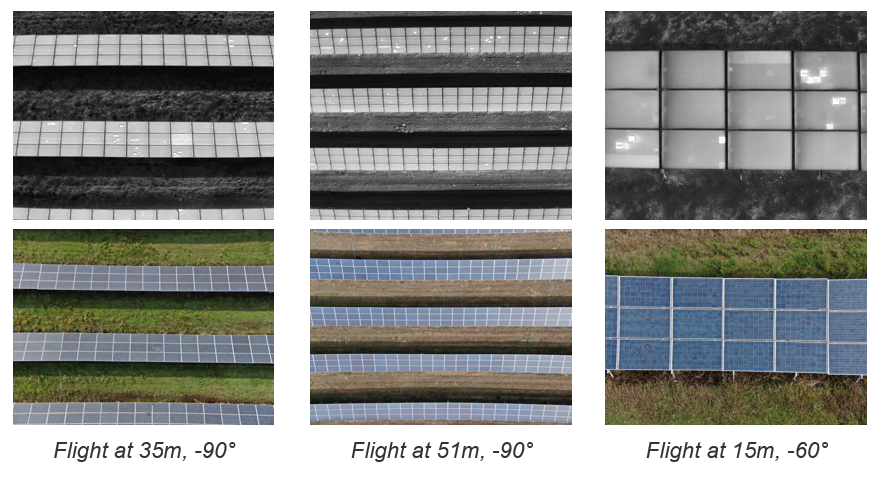|
20 Sep 2023 |
|
|
20 Sep 2023 |
|
|
20 Sep 2023 |
|
|
15 Jan 2023 |
|
|
22 Sep 2022 |
|
|
30 Apr 2022 |
|
|
25 Jun 2021 |
|
|
01 Jun 2021 |
|
|
19 May 2021 |
|
| 20 Sep 2023 |
Face-to-face meeting at the Reliegos PV plant in León, Spain |
 |
| 20 Sep 2023 |
Flight experimentation tests |
|
Multiple drone flights were performed to demonstrate in an operational environment the capabilities of the developed unmanned aerial vehicle (UAV) decision-making system. Flights at different heights and taken images are presented below.  The aerial platform was able to takeoff and perform each flight plan autonomously. The first flights were conducted at a height of 35m and a fixed camera angle of -90o, providing solar panel captures with a spatial resolution of about 3.3cm/px. Subsequently, more flights were performed at a height of 15m to further increase the quality of captures, setting the cameras’ alignment with the panels’ plane. The produced resolution provides highly detailed captures revealing even sub-cell defects. Finally, the aircraft was able to acquire imagery at a height of 51m, aiming to produce an overview of the plant. |
| 20 Sep 2023 |
Dr. Andreas Livera Presented his Latest Work on PV Systems at the 40th EU PVSEC 2023 |
Last week, FOSS Research Centre post-doctoral researcher Andreas Livera delivered a poster presentation on “Unmanned Aerial Vehicle (UAV) Decision-Making for Photovoltaic (PV) Plant Diagnostics Using Image and Electrical Data Analysis”, as part of the AID4PV’s activities, at the 40th European Photovoltaic Solar Energy Conference and Exhibition (EU PVSEC 2023). The EU PVSEC is the largest international Conference for Photovoltaic research, technologies, and applications, with the conference's scientific programme coordinated by the European Commission Joint Research Centre. At the same time, the EU PVSEC serves as a PV Industry Exhibition, where specialised PV Industry presents technologies, innovations, and new concepts in the upstream PV sector. In this vein, the global PV community comes together under the auspices of the annual gathering to present and discuss the latest developments in Photovoltaics, as well as to network and conduct business. This year’s edition of the EU PVSEC, which took place in Lisbon, Portugal, between 18 and 22 September 2023, celebrated the 40-year-long history of the science-to-science and science-to-industry platform that is uniquely focused on the global PV Solar sector.  |
| 15 Jan 2023 |
Recent updates on the AID4PV’s milestones |
On TSK side, the company has been working on the PV plants defects characterization, also in the PV plant physical and reliability models, based on thermography and electroluminescence, and finally on the RGB & thermal defects categorization using UAV images.   On UCY side, the team has been working on the development of an EL image processing tool. Also, the team has been working on the creation of an image database using labelled EL images of healthy and faulty PV modules of different technologies. Current activities focus on the development of pre- and post-processing image techniques for the detection and classification of defects in PV modules.  On TUC side, the team has been working on the geolocation of defects on the UAV-captured images. A new geolocation algorithm has been developed for that purpose. The principle of operation of this algorithm is demonstrated in the following case study of a PV plant which lies within the TUC premises in Chania, Crete, Greece.
Step 1: A 3D model (in WGS-84 reference system) of the PV plant is developed using appropriate photogrammetric algorithms and software.  Step 2: The user selects the area of interest. By selecting the four corners of the panels’ region of interest, the user can derive any point inside the panel in WGS-84 geodetic system.  Step 3: To ease the procedure for geolocating the defects, the algorithm applies a perspective correction.  The TUC team also evaluated the feasibility of development a UAV-based solar panel cleaning system. An extensive literature survey has been carried out to identify (a) the most significant factors (i.e., dust and sand, organic detritus, leaves/bird droppings, air pollution, etc.) which affect the solar panel cleanliness and subsequently its operational efficiency, and (b) existing technical solutions (i.e., air-jet, dry-sweeping, water-jet, soaking, etc.) to mitigate the solar panels’ cleanliness problem. As a first approximation, although UAV-based solar panel cleaning is technically feasible, especially for light, non-adhesive contamination, it seems that a system which relies solely on a UAV-born robotic arm is rather impractical and cost-insufficient and uneconomical. |
| 22 Sep 2022 |
A mid-term report of the project has been sent to the SOLAR-ERA.NET Coordination Office |
| 30 Apr 2022 |
The cameras and UAVs to be used in the project have been selected and the purchase process initiated |
| 25 Jun 2021 |
Consortium agreement has been successfully signed |
| 01 Jun 2021 |
AID4PV started its activities at transnational level |
| 19 May 2021 |
AID4PV’s kick-off meeting has taken place |